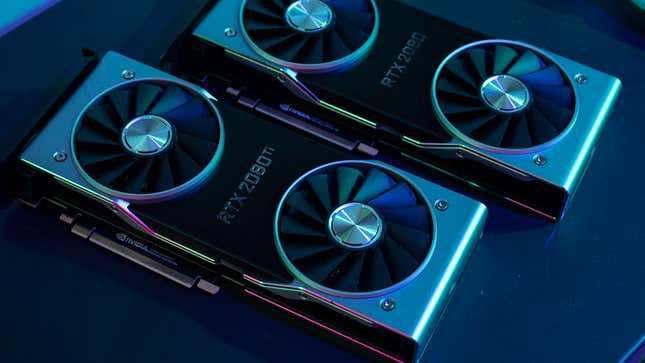
Now that we’re getting closer to Nvidia’s anticipated September 2020 release date of its next-generation GeForce RTX 30 ‘Ampere’ graphics cards, rumor has it that the company is already ceasing production of some RTX 20-series cards.
According to Wccftech (by way of Japanese news site Ithome), Nvidia has not only just stopped production on the RTX 2080 Ti, RTX 2080 Super, RTX 2070 Super, and RTX 2070, but those four cards will also be delisted by major vendors soon. That’s most of Nvidia’s current high-end and ultra-enthusiast segment of GPUs.
If this feels a little bit like déjà vu, you’re not alone. Around the same time as Nvidia’s RTX 20-series launch in October 2018, a surge in cryptocurrency mining created a graphics card shortage. As a result, prices skyrocketed. It also didn’t help that Nvidia had announced it would be stopping production on its GTX 10-series cards to make way for the RTX 20-series. So not only were those cards in short supply, they were even more expensive than when they were first released. The GTX 1080 Ti, for instance, debuted with an MSRP of $700, but during the discontinuation and shortage, it went for as high as $1,000 or more from second-hand sellers. That’s also the current cost of the RTX 2080 Tis.
Assuming reports of Nvidia ceasing production of the 20-series cards are true, it’s likely we’ll see the same thing happen again, as cryptominers are starting to snatch up GPUs. Cryptocurrency miners prefer GPUs to CPUs these days because GPUs have more Arithmetic Logic Units (ALU), which perform mathematical computations. That means they can perform more calculations, which leads to more output during the mining process. Some cryptominers run dozens of these things at a time, so it’s easy to see why a GPU shortage happened two years ago, and why it can possibly happen again.
According to Bitcoin, the Bitcoin market reached its highest difficulty jump of all time today, which means it’s much harder for miners to make a profit. Many will likely shut down their machines temporarily until it falls again. Bitcoin forecasts that asset prices could reach as high as $19,044 by the end of this year, so it seems like as long as the mining difficulty stays low, then more miners will be encouraged to buy up whatever RTX 20 graphics cards are left in the market, driving up prices for actual consumers looking to purchase just one card for their PC.
But I don’t really speak Bitcoin. All I understand is, “Hey, this thing might get discontinued soon, so better get it now before prices go up.” It’s possible that all four of those RTXs will see similar price increases like the 10-series did. Given that the 1080 Ti jumped around $300-$400 in price near the end of 2018, the 2080 Ti could end up being $1,500-$1,600 by the end of the year. Insert sobbing emoji here.
It’s also curious that Nvidia would only discontinue the RTX 2080 Ti, RTX 2080 Super, RTX 2070 Super, and RTX 2070, though I imagine it has everything to do with the architecture of the next-gen graphics cards. Ampere is supposedly a major upgrade from the current Turing architecture, and the RTX 3080 (name not confirmed at Nvidia at this time) might be 30% faster than the RTX 2080 Ti. If that’s true, then it’s likely the RTX 3080 will be able to output more than 60 frames per second in most games paired with the right CPU—with ray tracing on, too. Because the RTX 20 cards are targeted for those who want to spend the big bucks on performance, it makes sense to release those first and leave the RTX 2060 Super, RTX 2060, GTX 1660 Ti, GTX 1660 Super, GTX 1660, GTX 1650 Super, and three GTX 1650 variants as its mid-range to lower-end options.
I expect expect the RTX 3080 to be way more expensive than the RTX 2080 Ti when it was launched. If there was a $300 MSRP jump between the GTX 1080 Ti and RTX 2080 Ti, then there could be another $300 jump from the RTX 2080 Ti to the RTX 3080, which would put the RTX 3080 at an MSRP of $1,300—assuming it does actually have the performance increase to justify the price hike. We’ve also heard rumors of a RTX 3070 Ti and RTX 3070, which could cost between $400-$500, which is how much the RTX 2070 Super and RTX 2070 cost currently.
AMD is rumored to announce its next-gen GPUs before the end of this year as well, so we might need to wait just a little bit longer for official product launches. Still, it feels weird to hear that these RTX cards could be headed for obsolescence really soon, just two years after their initial release.